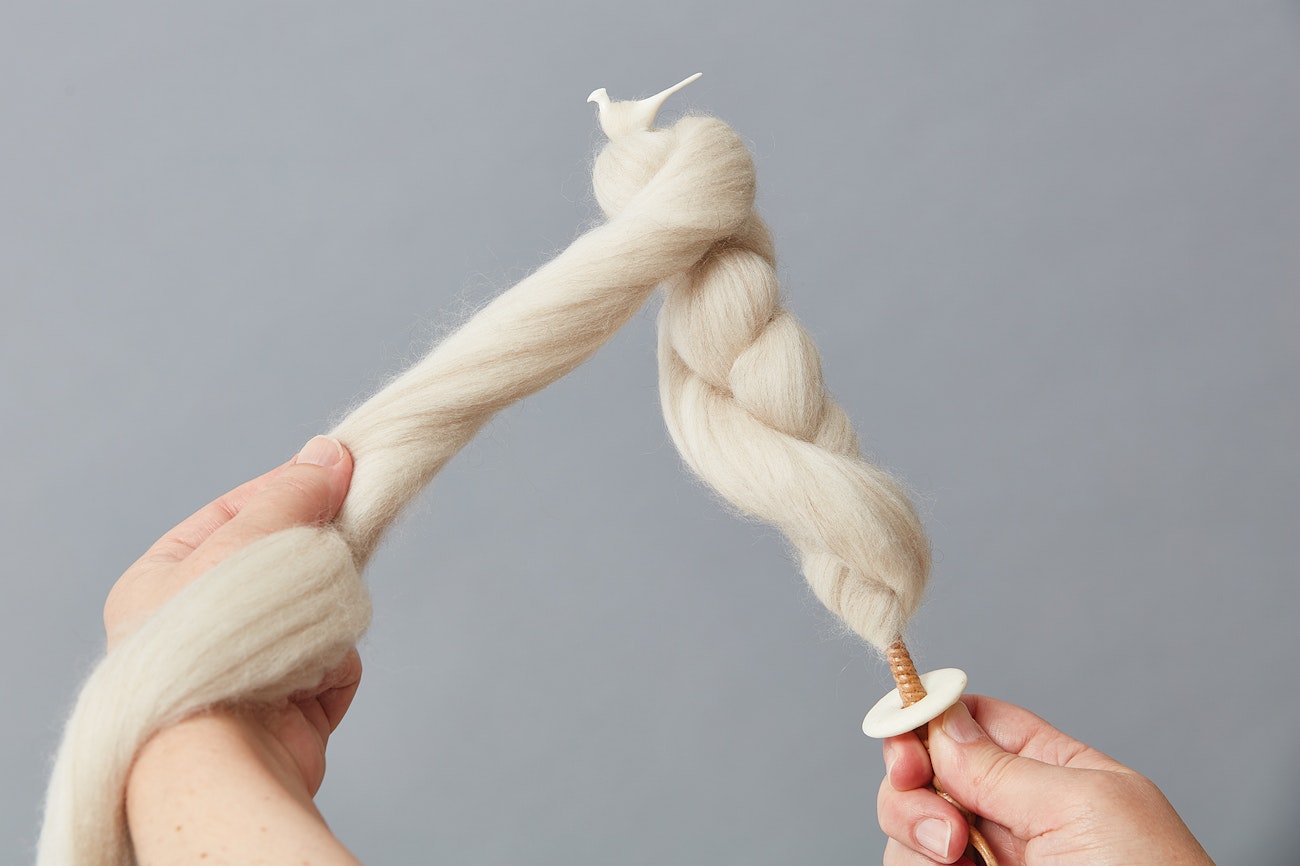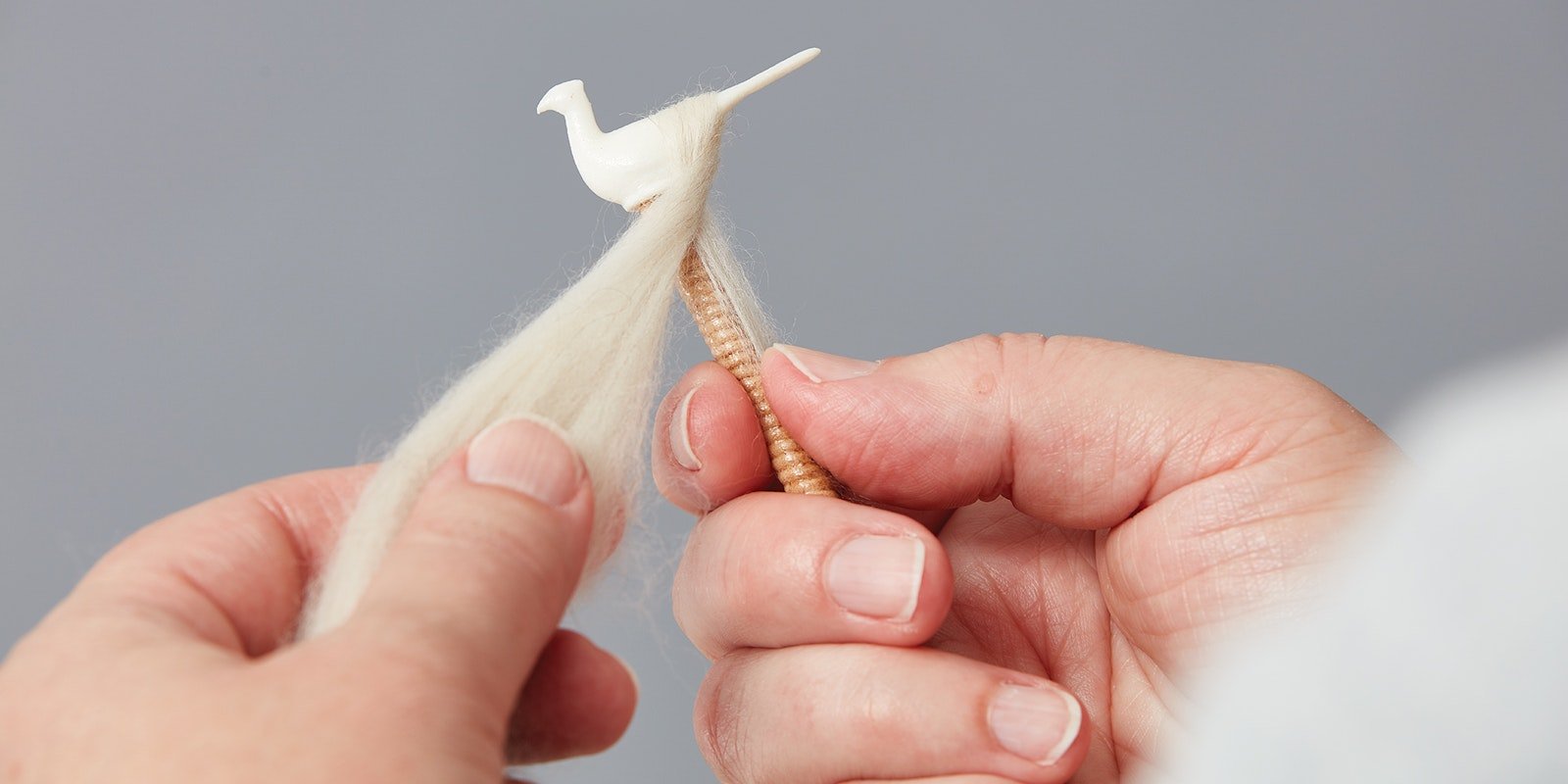What if there was a handspinning tool that could help manage your fiber supply while spinning on the go? Meet the distaff! Contributor Kim Caulfield introduced us to this surprising stick in the Fall 2018 issue of Spin Off. Here are Kim’s top tips for spinning with a distaff.
Most people who learn to use a drop spindle begin by holding the fiber in a death grip. They are afraid the spindle might drop, so they clench their teeth and both hands, too. Then, as they try to draft a bit of fiber out and down, the fingers of the fiber hand are pulled downward, and the left elbow rises and sticks out like a wing. In extreme cases, the elbow climbs higher, forcing the back to twist. The result is a human pretzel. Spinning like this is painful, and it usually doesn’t take long for such spinners to decide that they really don’t like spindle spinning. How sad.
Handheld distaffs accommodate most fibers with a staple length between 2 and 5 inches (5–12.5 cm). For fiber less than 2 inches (5 cm) long, try a distaff with a whorl. Most modern combed top or roving will work well. Hand-combed fiber is perfect, though you may wish to lay two or more strips together. Drumcarded batts may need to be split into multiple sections.
How to Spin with a Distaff
 Step 1
Step 1
Step 1 To begin loading the distaff, loop the tip of the fiber around the top of your distaff. With some fibers or some distaffs, you may want to tie this tip in place with a smooth ribbon or cord.
 Step 2
Step 2
Step 2 Begin wrapping your fiber in a Z spiral around the shaft, but don’t pull it tight. You may add a little twist as you go to help keep layers of fiber from clinging together. Don’t wrap all the way down the shaft; remember to leave room for your hand.
 A full distaff
A full distaff
Step 3 Hold the loaded distaff in your left hand. If your distaff has a ring, slip your little finger through it, then curl your fingers loosely around the shaft. If you have a midwhorl distaff, let the whorl sit between your index finger and middle finger. Let the tip of your fiber come under your index finger to form your drafting triangle.
 Spinning from the distaff
Spinning from the distaff
Step 4 Now you’re ready to spin. Keep your left hand curled, but not clenched. If you feel the fiber drafting too fast, close your fist for a moment.
 loading a larger amount
loading a larger amount
Step 5 When you are comfortable spinning from a distaff, you may want to try loading on more fiber. Spiral down as before to load the first layer, then slant quickly back to the top and begin spiraling down again. This lets you pack more fiber on your distaff, but it also requires a bit more care to unwind just enough to spin easily.
How Not to Spin
With your fiber clenched between finger and thumb, your wrist and index finger will get sore. As you draft downward, your left elbow rises, another uncomfortable position. This spinner needs a distaff!
 Holding the spindle and fiber at this angle over long periods of time can cause a repetitive use injury which would mean time away from spinning!
Holding the spindle and fiber at this angle over long periods of time can cause a repetitive use injury which would mean time away from spinning!
This article can be found in the Fall 2018 issue of Spin Off.
Also, remember that if you are an active subscriber to Spin Off magazine, you have unlimited access to previous issues, including Fall 2018. See our help center for the step-by-step process on how to access them.
Kim Caulfield has been spinning and collecting odd spinning wheels and spindles for decades. She raises sheep in Tennessee, and she is passionate about sharing her love of natural fibers and spinning.
Originally published December 29, 2021; updated May 13, 2022.

